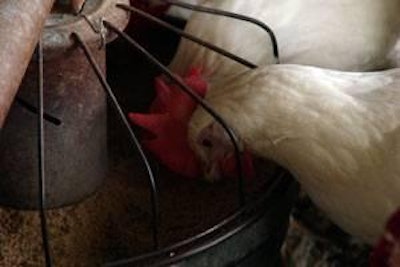
Feeding programs have undergone increasing complexity and sophistication since the 1950s following progressive advances in nutrition and computer technology. Applying accumulated knowledge to the needs of specific production segments of egg production has facilitated a relative reduction in feed cost expressed per dozen eggs or pound of liquid.
Development of feeding programs for laying hens
Until the 1950s, flocks held on small-scale farms were generally fed a single diet for their entire laying cycle. Feeds were generally purchased from local mills or affiliates of national suppliers. Diets were formulated on the basis of margin, which could be generated on sales given available ingredients and their cost. This is the simplest feeding program to implement. However, protein and hence amino acid intake could not be adjusted with age or feed intake resulting in excess cost of protein and reduced shell quality due to excessive egg size.
During the 1960s phase feeding programs were introduced. Dietary specifications were based on age and production. Feeding less protein as egg mass declines helps control egg size, improves shell quality and has the potential to reduce protein cost by up to 2 cents per dozen or more. Phase feeding requires a wide range of diets and offers no means to control protein intake with changes in feed consumption.
Phase feeding based on intake followed in the 1970s in responding to the reality that intake is influenced by house temperature. By adjusting dietary protein levels as feed consumption changed, protein intake could be held constant. Feeding based on intake in addition to phase feeding based on age provides even more control over egg size and shell quality and reduces protein cost by up to 4 cents per dozen or more. Successful implementation of phase feeding requires effort, skill and a range of diets along with accurate records of performance and intake. Prior to the 1990s crude protein, or in some case amino acid requirements, were set by feeding graded levels of nutrients and specifying the amount that gave the best performance and feed efficiency. Since the value of eggs or price of feed have no influence on nutrient requirements for performance, neither cost nor revenue were generally not considered in setting nutritional requirements and any consideration of cost efficiency was generally disfavored by journal editors.
Econometric feeding and management (EM&F) programs were introduced in the 1990s. This innovation diverged from the classic approach to feeding for optimum performance to introduce the concept of cost per dozen eggs or pound of liquid produced. Egg and liquid prices and feed cost are integrated into programs which allocate a range of available ingredients among specific diets representing phases and intake levels. The approach allowed producers to see the effect of changing egg and feed prices on protein requirements and helped to more accurately implement phase feeding programs based on intake.
Being able to quantify how returns varied as feed and egg prices changed gave producers an additional criterion to consider when selecting diets contributing to a potential increase of up to 2 cents per dozen or more in addition to the value obtained by phase feeding based only on intake. Producers could also appreciate the spread in egg price due to size and the effect on feed price due to varying energy and protein cost ratios which were just as important in determining protein requirements for optimal returns as absolute egg and feed prices.
In 2007 advanced EF&M programs were introduced that integrated phase feeding programs based on intake, a least cost feed formulation program, an EF&M program, a record keeping program, and a production control program into a single package.
This allowed producers to evaluate:
- The protein and energy requirement for optimal performance and feed efficiency since egg and feed prices are not considered in a traditional feeding program.
- The protein and energy requirement for optimal returns considering both egg and feed prices.
- The cost associated with over-or under-feeding protein as egg and feed price change applying EF&M feeding.
- The cost associated with over or under feeding energy as egg and feed price varies when feed allocation is based on intake.
- The cost associated with over- or under-feeding protein and energy as egg and feed price changes with traditional phase feeding.
Because protein and energy represent up to 85% of feed cost and 60% or more of variable production cost, it is important to integrate and summarize the above information along with flock performance criteria needed to select diets based on phase and intake. The integration of the five programs into a single package simplifies feeding based on intake while at the same time helping to optimize performance and return.
Knowing the cost associated with over- or under-feeding protein and or energy in written form as feed and egg prices change is not the sole factor in selecting diets with specific protein levels. It is only one of the many criteria including egg production and case weight, hen age and weight, feed consumption, house temperature, grade requirements of the market. EF&M is used to optimize protein efficiency, flock performance and returns when phase feeding is based on intake.
Econometric feeding and management programs for egg products
The introduction of an EF&M program for the breaker segment of the egg industry in 2010 showed the protein (or specific amino acid) and energy levels required for optimal performance and return as feed and liquid egg prices changed. Costs associated with over- or under-consumption of protein and or energy are shown in cents per pound of liquid egg and dollar value per million hens per week. One cent per dozen. spread over a million hens represents $250,000/year. Because feeding can easily influence returns by up to 6 cents per dozen appropriate selection of diets and feed allocation are significant to return.
Feeding programs and feed formulation are equally important in optimizing performance and profit and requires integrated software packages.

















